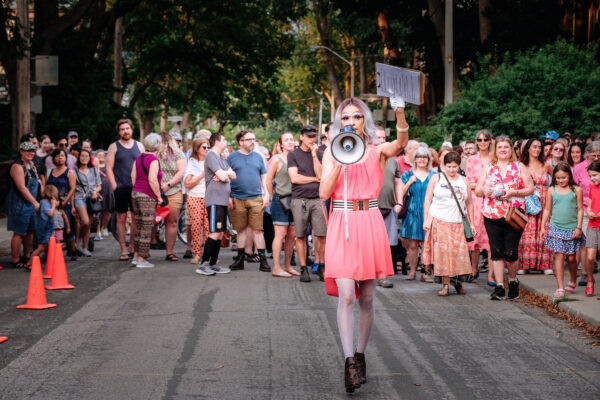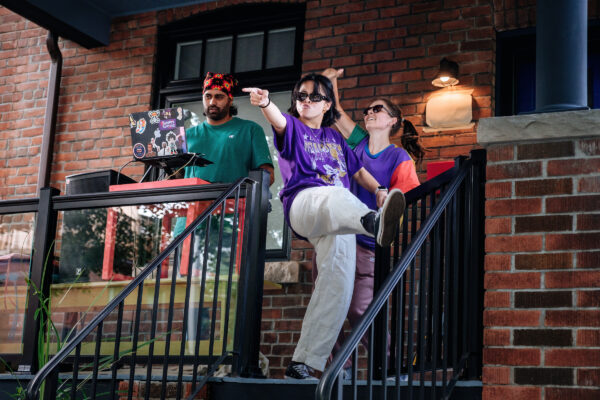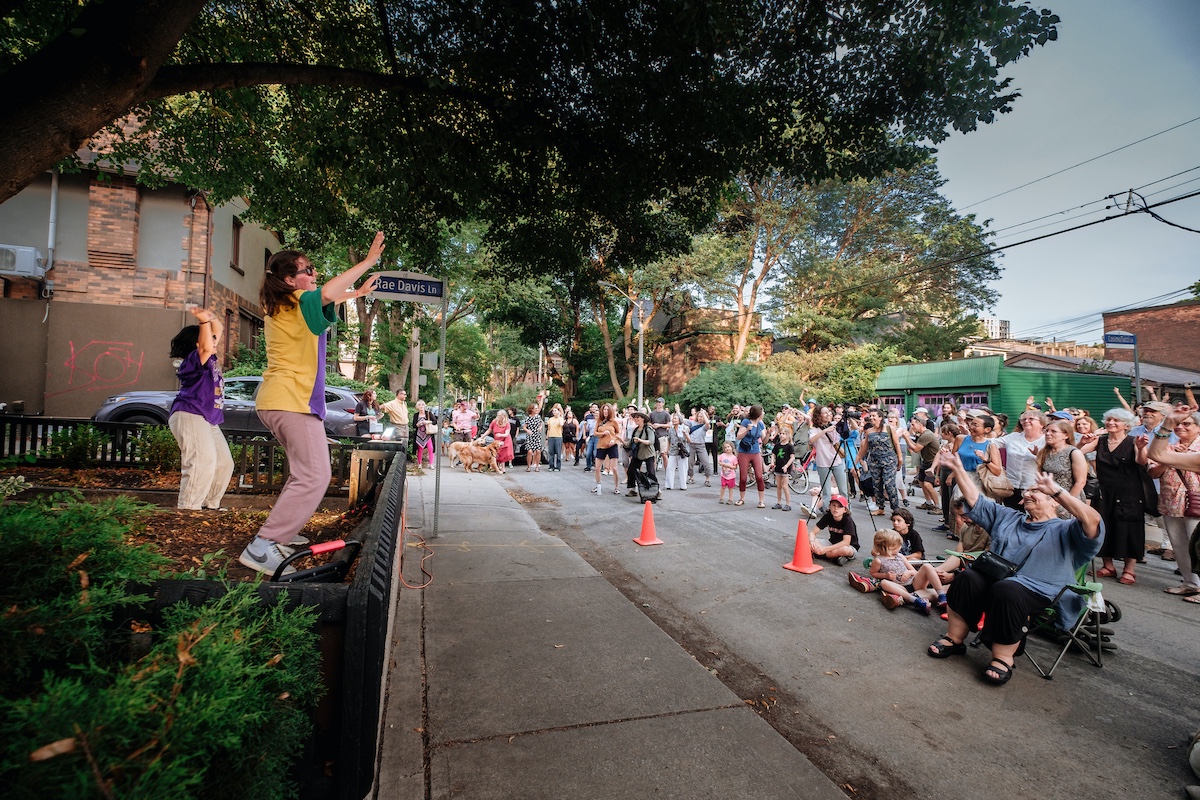
Porch View Dances celebrates the stories of people in a neighbourhood, pulling dance out of the theatre and inserting it into our daily lives. The event sends the powerful message that art is for everyone.
The brain child of Karen Kaeja, Porch View Dances began in 2012. Audience members embark on a journey through a Toronto community to witness the art of professional choreographers, brought to life by the neighborhood’s residents, many of whom have no formal dance training.
After viewing each dance, the audience moves to a local park for what Kaeja calls a “flock landing.” Individuals of any age or ability are welcome to take part in the performance.
When I heard about Porch View Dances, I seized the chance to speak with Mayumi Lashbrook, the professional dancer and choreographer tasked with curating this year’s community dance initiative.
Dancing With a Community
A few years ago, one of my childhood best friends got married. Little did she know, I fulfilled a long-awaited dance dream of mine at her wedding.
My friend came from a Croatian family, so traditional Croation dancing was part of the evening. I got to join in on a kolo! (That’s a style of “circle dance” common in Eastern European cultures.)
The kolo was easy to learn, and the laughter was infectious, making it one hell of a jolly good time! Trust me: no one cared if they were pointing their feet, lifting their chin, or holding down their rib cage.
Porch View Dances supports the same approach to dance.
“When I started curating this festival,” Mayumi said, “I had just done a dance class where it was literally all ages. It was four-year-olds to sixty-five-year-olds.”
But she noticed something interesting: the older people in the room hesitated as soon as they saw the children.
“I could see how much they were like, ‘Ooh, do I want to do this?’ But having those children in the space gave them so much permission to let go and just enjoy themselves.”
Mayumi allowed this joy and freedom to inspire her curation process for Porch View Dances.
“I think that’s so apt in how to perceive the work when you come. Judge it from a childlike mindset of ‘How would I see this if I was seven years old? Would I enjoy it?’ Oh yeah. Heck yeah.”
Dance and You
Neither Mayumi nor I believed we could be professional dancers because our bodies didn’t do what was required to perform in a way that audiences would welcome. In my case, I didn’t get into a prestigious ballet school in part because my rib cage was the wrong shape. No joke.
“That’s why I didn’t want to pursue dance when I was young,” Mayumi said. “I couldn’t get my leg to my head.”
We’ve both come to learn that dance is inclusive of all body types, ages, and mobilities. The dancer—and I mean here a person who dances, with or without formal training—molds dance to suit their body, not the other way around. Porch View Dances celebrates that.
Expressing Your Emotions Through Dance

As easy as ADHD makes it to come up with ideas, having too many at once feels like TV static crackling in your mind, but you can’t find the off switch. After such a wonderful discussion with Mayumi, my mind became overwhelmed with a plethora of ideas for this blog post, causing me to freeze.
So, I put on some music and danced. This time it was Glay, because they’re my current phase. (Past phases have included Blake Neely—the composer for The Flash TV series—Dan Romer—the composer for Superman and Lois—a 60s hit station on Apple Music, and Alan Doyle.)
It took only two or three songs to calm the storm, leaving me elated and able to write again. If that had been my brain at night, I would’ve spent one or two hours trying to fall asleep while my thoughts raced like cheetahs on endurance enhancers.
Anyone can use dance and movement to replace that storm with happiness.
“That’s why I think it’s so impactful to see non-dancers in Porch View Dances,” Mayumi said. “These are people interested in expressing themselves regardless of athleticism or physicality. They’re taking the risk, and they have the courage to try regardless and to discover the parts of themselves that do want to move and do want to bop to the beat and laugh and have joy, because that’s what we all ultimately want in life.”
“Understanding” Contemporary Dance
When you watch a contemporary dance performance, or an abstract ballet or modern performance, do you believe everyone in the audience but you understands what’s happening? That they’re all seeing the same story?
While it’s true that many choreographers create with intent, you (the viewer) do not need to learn some kind of secret language to decode it.
“I’d say with contemporary dance, one of the most beautiful things that you can walk in with is this openness and curiosity of, ‘what do I feel when I watch it?’” said Mayumi. “Whatever you’re feeling, whatever you’re sensing, that is the right thing.”
Having only watched musical theatre growing up (ballet bored me as a child—that’s a topic for another post), I also struggled with understanding abstract dance for a long time. Several years ago, I interviewed renowned Canadian contemporary dance choreographer Yvonne Ng. She shared the same advice as Mayumi did with me this month, and now I let my mind wander as I watch contemporary dance. The experience has become much more enjoyable.
“There isn’t a way to get dance wrong,” Mayumi said. “Whatever impacts or sensations come up for you—that part of the reason folks dance—is because of that sensation that their bodies feel when they’re moving. Whatever you feel watching someone else do, that is a beautiful transfer of experience.”
Stop the Inner Critic
For most of us, we need only see ourselves in a mirror for a split second before the thoughts start coming:
- I could lose a few inches on my hips.
- Has my jawline always been that short?
- Why do these jeans, which I’ve had for six years, suddenly make me look fat?
- I remember when this body was young…
And on and on and on.
Have you ever marvelled at how young children don’t do that? Mayumi has curated Porch View Dances from that point of view.
“We had an open call for choreographers, and one of the things I was so excited about in reading the applications was the viewpoints that these folks were coming from. Something that was really clear through all the different applications was this idea of play.”
Play. Not a word many adults use joyfully these days, is it? Sure, we’ll play an instrument or play a sport, but those types of play have clear purposes. But when did you last play the way a child means it?
“In a moment now where I feel that we’re coming out of isolation, we’re trying to learn how to be back in relationship to each other,” Mayumi explained of her thoughts as she curated the event. “And with that comes conflict, with that comes strife. And so seeing these voices from people who recognize that conflict, but regardless of that still are looking to come out with joy and play with something, that was really apparent in all their applications.”
Dance Is About You and the Community Around You
When it comes to contemporary dance, there’s nothing “to get.” It’s about opening your mind to just let in whatever you observe.
“Remember that feeling of awe, of people moving their bodies in space, of jiving to the rhythm and just expressing how they want to with no judgment for their bodies,” Mayumi said.
Dance is community. You don’t need to be a professional dancer to enjoy it. Just move and groove. If you’re in Toronto, visit Seaton Village July 17th to 21st, 2024, to see a community get together and celebrate dance. Full details, plus highlight videos from previous years, are on the Porch View Dances website.


